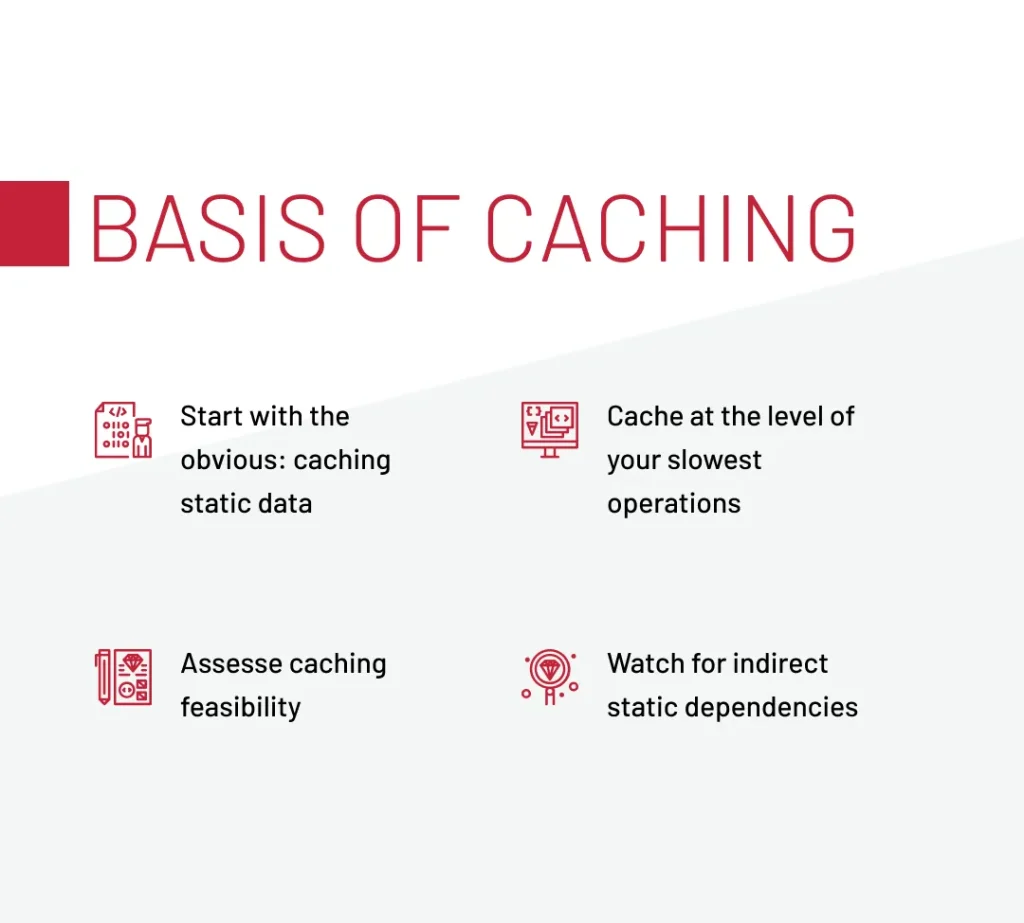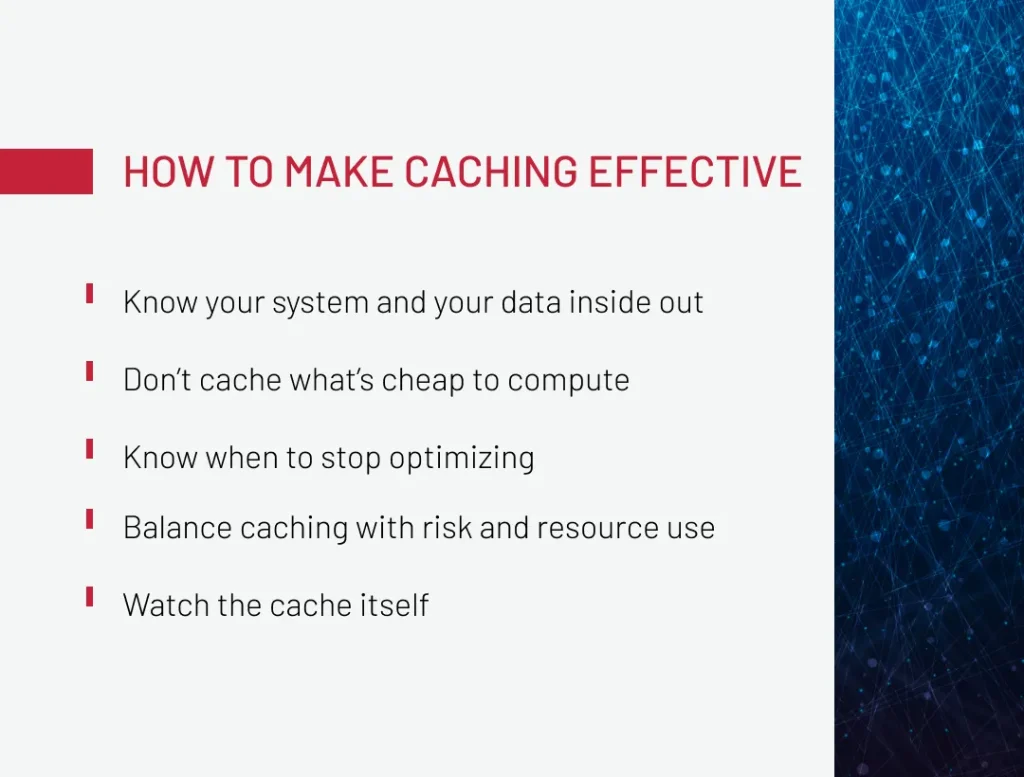How to Implement an Effective Caching Strategy for High-Traffic Ecommerce Websites

Ecommerce caching is a double-edged sword. One minute it’s improving performance, and the next, it’s serving stale data and murdering your flash sale.
That’s the thing about caching: it’s simple enough to implement, yet far more difficult to do well. The issue isn’t so much if you can put a cache in place, but whether you should, and how you manage it so that it works for you.
Unfortunately, there are no plug-and-play caching solutions here. Some basic rules are defined, but they should be adapted to each business case. Spending years building high-load systems, we at Expert Soft have learned where the real complexity lies. This article uncovers caching strategies and how to choose the right one, together with the non-obvious trade-offs and edge cases.
Quick Tips for Busy People
Looking for a brief outline? Here it is:
- Your architecture should dictate the caching implementation. Define what and where to cache as well as available approaches early, based on the structure you’re building.
- Use caching where it truly matters. Combine static data caching with targeted optimizations at bottlenecks and aggregation points for real performance impact.
- A good caching strategy is precise, monitored, and sometimes skipped. Cache only when it adds real value. Otherwise, it may hurt more than help.
- Don’t mistake repeatability for slowness. If an operation runs frequently but is fast and lightweight, caching it might waste memory and complicate your codebase.
- Watch for stale dependencies hiding inside dynamic requests. Repeated lookups of embedded static data, like category names or tags, can create silent slowdowns if not cached smartly.
We’ve covered the high-level picture, and now let’s dive into the details on how to build an effective caching strategy for your system.
Things to Consider at the Planning Stage
Caching isn’t an afterthought. It’s a design aspect that needs to be considered upfront. If you’re developing an ecommerce site with high loads, these are the questions and concerns you need to deal with before you begin to implement anything:
-
Have you factored caching into your system’s resource pool?
Caching is not an endless reserve you can use without limits. It draws on your app’s memory and resources. So, besides speed, caching also adds load. Determine how much you can afford to cache and what is truly worthwhile. This isn’t free optimization, and there is a cost associated with it, so consider the cost upfront.
-
Have you identified what’s safe to cache?
Not all data should be cached. Focus on what doesn’t often change or what you can easily track for changes. If you’re planning to cache things like inventory or pricing, especially when they sync with external systems, make sure you also plan for how to keep it fresh.
-
Is caching integrated into your architectural vision?
Caching is something you must introduce into your infrastructure design: provide memory for it, specify how and when to invalidate data, and make sure the approach fits your system design. Some forms of caching will be unfeasible depending on your architecture. In microservice architectures using CQRS, caching read-side data requires a well-orchestrated invalidation strategy, often using message queues or pub-sub models to maintain consistency. Without it, you risk serving stale data.
In a nutshell, by the time you’re ready to talk strategy, you should already know what data can be cached, and where it makes the most impact. Get the planning right, and your cache strategy will feel like part of the system.
Basis of Caching Strategies
Even though there are no universal caching strategies, there are foundational principles. These basics won’t cover your entire approach, but they’re the building blocks you can’t possibly do without.
Starting with the obvious: caching static data
The most basic rule is that if your data is static and read often, cache it. That’s the classic starting point. It’s simple, effective, and a good entry into performance optimization.
But here’s the truth: most ecommerce platforms don’t have enough truly static data to move the performance needle on their own. This means that caching static content alone, think terms and conditions pages or product category names, won’t cut it. It’s useful, but only as part of a broader strategy.

Caching at the level of your slowest operations
The second key principle: put your cache in places where performance bottlenecks actually occur. This is the foundation of the cache-aside pattern, where your application logic explicitly loads data on demand, based on bottlenecks.
If your database queries are the slowest part, put your caching layer above the DB. This is a typical use of read-through caching, where the cache transparently fetches from the source if data is not available.
If latency is caused by network overhead between the client and server, edge caching can significantly improve perceived performance. This typically refers to CDN-based caching or reverse proxies (e.g., Cloudflare, Akamai, Varnish) caching static or semi-dynamic content near the user. However, it’s only applicable when:
- The content is either static or can be safely cached for a short TTL.
- There’s no user-specific data in the response.
For personalized or fast-changing content, consider hybrid approaches like stale-while-revalidate or moving logic to edge functions if supported by your infrastructure.
Assessing caching feasibility
Defining where caching actually brings value is just as important as deciding how to implement it. Not every request needs to be cached, and in some cases, it might offer little to no benefit.
Consider cloud-based databases, for example. The speed gain from caching in this case will probably be minimal or nonexistent since cloud providers are already optimized for handling typical data access patterns. Or if, say, your back-end is distributed and data consistency isn’t guaranteed, client-side caching could result in displaying stale or incorrect data. We at Expert Soft often keep these peculiarities in mind, especially in terms of SAP Commerce (Hybris) development, not to overwhelm the system with unnecessary caching.
Watching for indirect static dependencies
It’s easy to focus on caching direct calls to static resources, but it’s common to miss when the same static data is embedded within other operations. For example, a product page request might fetch product info dynamically but also load the same category or tag data every single time. These hidden patterns can quietly slow things down if left unoptimized.
Here’s one example from our project: full-text product indexing was painfully slow, taking several hours to complete. The actual issue wasn’t the quantity of the products. It was the system that was rebuilding the same category structures over and over again.
Certain categories were shared across multiple parent categories, and each time the indexer hit one of those parents, it recalculated all shared subcategories from scratch, including their localized names. Instead of reusing what was already processed, it kept looping through the same logic. Once we cached the structure in memory, indexing time dropped by 30 times, because the system did not need to repeat the same calculations.
Even with clear caching principles in place, real-world conditions will test your original scheme. As your system operates, real load, usage patterns, and user behavior will often expose bottlenecks you never anticipated. That’s why flexibility is key: your strategy must mature along with your product.
To evolve successfully, below are a few recommendations.
How to Make Your Caching Strategy Effective
In our experience at Expert Soft, making caching work at scale means understanding the edge cases and the trade-offs and sometimes knowing when not to cache at all. Here are some tips.

Tip 1: Know your system and your data inside out
You can’t cache in a vacuum. Not even seasoned developers can enter a project blind and figure out what ought or ought not to be cached. Your team needs deep domain knowledge, not just of caching principles, but of your system’s business logic, data flows, and update frequency.
In some cases, system specifics may call for a non-standard caching approach. For example, in an ecommerce setup with a fast-changing product catalog tightly integrated with an ERP system.
Here, traditional caching might be too rigid to keep data reliably fresh or send too many requests to a database, causing significant performance bottlenecks. In such scenarios, using a search engine with built-in mechanisms for data freshness and caching on that level can be a better fit, as cache can become a liability rather than a boost.
Tip 2: Don’t cache what’s cheap to compute
Let’s start with the basics and then dig a little deeper. The base rule is simple: if you’re working with a fixed set of data and applying a predictable set of operations, caching is the right move. It helps you skip repetitive processing and speeds things up with minimal overhead.
For example, in one of our projects, we had a fixed set of URL patterns used for routing and validation. The URLs didn’t change, the logic was clearly defined, and everything looked straightforward. On the surface, this was a textbook scenario for using caching.
And here’s the tricky part: if the data processing is trivial and barely consumes resources, caching might not be necessary at all.
In fact, the situation above could have easily fallen into that category. Everything was already optimized, and adding a cache could have just increased memory consumption without any real gain. This is where you need to evaluate how much time you’re saving per request and whether the cache is pulling its weight.
We still implemented caching in this case. Why?
Because our routing relied on pattern matching, and in Java, that’s not as fast as you might think. In our case, the language-specific behavior made all the difference. We added a cache that stored the mapping between each incoming URL and its resolved action. If the URL had already been processed, the system could instantly return the result without running through the logic again.
Here, the computational cost justified the decision. But the takeaway stands: even with fixed data, caching only makes sense when the workload demands it. Sometimes it will. Sometimes it won’t.
Tip 3: Know when to stop optimizing
There are cases where reducing response time makes a big difference, such as taking a 3-second request and turning it into 800ms. That kind of improvement is noticeable and meaningful. But once your system is already performing well enough in terms of usability, further optimization may have little real impact.
We’ve seen teams push from 500ms to 200ms, chasing micro-gains that users will probably never feel. Meanwhile, those final milliseconds come at the expense of time, complexity, and infrastructure resources.
The point is that it’s not just how much faster you get, but what basis you’re measuring against. And smart caching is knowing when the speed you already have is sufficient.
Tip 4: Balance caching effort with risk and resource use
In our practice, there was a case where cache invalidation was done manually: whenever someone inserted data directly into the database, they’d also update the cache by hand. That’s a classic example of what not to do. Manual handling opens the door to human error, and the system has no way of knowing the data has changed unless it’s told explicitly.
Ideally, cache invalidation should be automatic and event-driven. Most effective strategies include:
- Write-through caching, where writes go through the cache and update the source.
- Publish-subscribe mechanisms (e.g., Kafka, Redis Pub/Sub) to notify cache layers of updates.
- Change Data Capture (CDC) systems like Debezium to track updates and invalidate or refresh cache entries.
If automation isn’t feasible, the minimum requirement is coupling data change operations with cache invalidation logic directly inside your system, ensuring consistency without manual effort.
Tip 5: Watch the cache itself
A good strategy is also about monitoring the cache itself. Two things matter most: volume and freshness.
Expert Soft has taken part in a global ecommerce project, where a promotional banner failed to update during a major campaign. The problem was related to the CMS module, which was cached too aggressively, and outdated content was being delivered at the worst time. We fixed this with a no-cache flag. However, it illustrated a significant point: even properly planned caching may fail if freshness isn’t monitored appropriately.
The same goes for volume. If you’re not watching cache size, it can quietly get out of control, consuming memory and degrading performance. Keeping an eye on both how much you’re caching and how current it is ensures caching continues to be a performance booster, rather than a drag.
When Cache Becomes a Burden
Caching is only beneficial if the underlying logic is sound. We’ve had a case where, on the surface, all was well, with no errors or crashes, but under the hood, the system quietly cached empty results caused by bad implementation logic. This led to unpredictable behavior and stale data. After we eliminated that logic and re-designed the caching strategy, everything worked as predicted.
This is a classic example of why poorly implemented caching can backfire. If your caching logic is faulty, you still end up serving incorrect or stale data. Cache is a tool, not a fix for broken code. And sometimes the best course of action is to tear it out and fix what’s broken.
To Sum Up
In high-traffic ecommerce systems, caching only works when it’s built with full awareness of architecture, data flows, and failure modes. You can’t just cache ERP-synced inventory or promotional content without planning for precise invalidation. And caching static data alone won’t fix deeper performance issues, like inefficient full-text indexing or repeated dependency lookups.
The takeaway is that caching is about knowing exactly what you can reuse, where it pays off, and where it might quietly break everything. If you’re wrestling with these questions in your ecommerce platform, Expert Soft has probably seen something similar. We’d be happy to share our experience, let’s talk!
FAQ
-
What is a caching strategy?
A caching strategy is a set of rules that define which data to cache, at which layer (client, server, or database), and for how long, to reduce system load, improve performance, and maintain data reliability.
-
What are the most common caching strategies?
Common strategies include static content caching, cache-first (serve from the cache if available), stale-while-revalidate (serve stale data while refreshing in the background), and read-through (fetch from source only if not cached), each balancing freshness, speed, and complexity differently.
-
What is static content caching?
Static content caching involves storing infrequently changing resources, like product categories, images, or policy pages, to avoid redundant processing or database access, improving performance, especially during peak loads, without risking data consistency.
-
What is a cache hit rate, and how is it improved by caching strategies?
This approach prioritizes returning results directly from the cache whenever possible, minimizing back-end calls and reducing latency. Techniques like cache-aside, stale-while-revalidate, and read-through caching improve hit rates by keeping frequently accessed data both available and fresh.
-
What is the cache-first strategy?
In a cache-first approach, the system always checks the cache first. If data isn’t found or is outdated, it fetches fresh data from the source and updates the cache for future use, balancing speed with accuracy.

Andreas Kozachenko, Head of Technology Strategy and Solutions at Expert Soft, guides the development of high-performance ecommerce systems. His hands-on experience with caching strategies ensures practical advice for handling high-traffic loads without compromising speed or reliability.
New articles

See more

See more

See more

See more

See more
